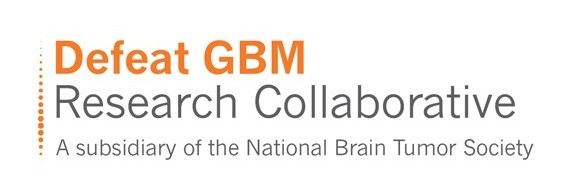National Brain Tumor Society
launched our Defeat GBM Research Collaborative in March of 2013 to great enthusiasm from both the patient and scientific communities.
As our boldest strategic research initiative to-date, the Defeat GBM Research Collaborative aims to double the five-year survival rate of glioblastoma multiforme (GBM) patients in just five years. We built around a funding and research model that is designed to rapidly move glioblastoma research progress through four synergistic and simultaneous projects that span the drug development pipeline from basic discovery science, through to translational research and pre-clinical drug development, all the way to clinical trial design.
In late August, we joined with strategic advisors Dr. Anna Barker, Dr. Webster Cavenee, and Dr. W.K. Alfred Yung, and hosted the rest of Defeat GBM’s research team, partners, as well as other potential collaborators from leading research institutions across the globe, in a scientific meeting that solidified the timelines, goals, designs, aims and integration of the four (4) individual projects that exist within the overall effort.
Meeting attendees included:
- N. Paul TonThat – CEO, National Brain Tumor Society
- Carrie Treadwell – Managing Director, Defeat GBM Research Collaborative, NBTS
- Dr. Paul Mischel – Ludwig Cancer Research
- Dr. Wenbin Li – Beijing Shijitan Hospital, China
- Dr. Ingo Mellinghoff – Memorial Sloan Kettering Cancer Center
- Dr. Sujuan Ba – COO, National Foundation for Cancer Research
- Dr. Otmar Wiestler – University of Heidelberg, Germany and German Cancer Research Center
- Dr. John DeGroot – MD Anderson Cancer Center
- Dr. Fred Lang – MD Anderson Cancer Center
- Catherine Stace – CEO, Cure for Life Foundation, Australia
- Matt Kapp – Cure for Life Foundation, Australia
- Dr. Frank Furnari – Ludwig Cancer Research
- Dr. Tim Cloughesy – UCLA
Dr. Yung, who serves as the Defeat GBM Scientific Director, summed-up the aims of the four projects, as:
- Identify the right biological targets driving the tumor and their associated resistance mechanisms
- Attack the targets with the right drugs
- Select the right patients to receive the corresponding drugs
- Test the treatments in the most effective clinical trials
From there the group of U.S.-based advisors and research teams deliberated and plotted the course forward for the four (4) simultaneous projects in target discovery, drug development, predictive biomarkers, and systems biology, as well as how all four projects teams would share and transfer ideas and data to help inform all of the various projects as they moved along:
Defeat GBM Project Overview
Discovery
- Ludwig Cancer Research, UCSD
- The major goal is to identify the right treatment target(s) and understand any associated resistance mechanism (how the tumors escapes or resist treatment).
- Targets identified here will be triaged into each of the other three projects to help understand how to overcome drug resistance in GBMs
Drug Development
- MD Anderson Cancer Center
- The team plans to accelerate drug development in two ways:
- Identifying existing molecules/drugs that can be applied specifically to GBM, both on their own and in rational combinations
- Developing novel drugs at MD Anderson specifically for GBM
- Simultaneous work in the discovery and biomarker projects will aid the team in matching and creating drugs for different patients and different molecular targets
Predictive Markers (biomarkers)
- Ludwig Institute for Cancer Research, UCSD
- The team will seek to develop predictive marker panels to guide therapy – including combination therapy – for each patient based on the molecular composition their tumor
- This work will feed into, and help inform, the simultaneous drug discovery project above, as any markers that are identified as predicating resistance will be screened by the MD Anderson team for drugs, or rational combinations of drug, that can be put together to defeat the particular resistance
Systems Biology
- Memorial Sloan-Kettering Cancer Center
- The major goal is to better understand the molecular and biological response to clinical inhibitors at the systems level to develop rational combination therapies
- Inhibitors screened in this project will help supplement observations made in all other projects
Discussion then shifted, after introductions by Dr. Cavenee, to the international researchers and executives in the room who had come to explore ways to incorporate their own efforts into the Defeat GBM Initiative, as well as other opportunities for future collaboration. Dr. Otmar Wiestler of the University of Heidelberg and German Cancer Research Center, Dr. Wenbin Li of the Beijing Shijitan Hospital in China, and Catherine Stace the CEO of Australia’s Cure for Life Foundation all discussed GBM-specific efforts happening in their respective countries. After the demonstration of these projects, which showed great collaborative work being done in the international area, the entire group agreed to continue discussion about the Defeat GBM platform’s potential for international expansion.
The meeting concluded with closing remarks from National Brain Tumor Society CEO, N. Paul TonThat, who invited all parties to attend the National Brain Tumor Society’s Annual Meeting & Summit in early October as the next ‘check point’ in the future of Defeat GBM.



